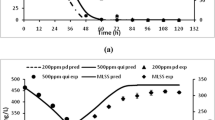Summary
It is demonstrated that bacterial growth on crystalline or adsorbed polycyclic aromatic hydrocarbons can result in a linear increase in biomass concentration. A simple mathematical approach is presented, showing that under these circumstances mass transfer from the solid phase to the liquid phase is rate-limiting for growth.
Similar content being viewed by others
References
Andelman JB, Snodgrass JE (1974) Incidence and significance of polynuclear aromatic hydrocarbons in the water environment. Crit Rev Environ Control 5:69–83
Bossert I, Bartha R (1984) The fate of petroleum in soil ecosystems. In: Atlas RM (ed) Petroleum microbiology. Macmillan, New York, pp 434–476
Daisey JM, Leyko MA, Kneip TJ (1979) Source identification and allocation of polynuclear aromatic hydrocarbon compounds in the New York City aerosol: methods and applications. In: Jones PW, Leber P (eds) Polynuclear aromatic hydrocarbons. Ann Arbor Science Publishers, Ann Arbor, Mich., pp 201–215
Davies JI, Evans WC (1964) Oxidative metabolis of naphthalene by soil pseudomonads: the ring-fission mechanism. Biochem J 91:251–261
Evans CGT, Herbert D, Tempest DW (1970) The continuous cultivation of microorganisms. 2. Construction of a chemostat. Methods Microbiol 2:277–327
Evans WC, Fernley HN, Griffith E (1965) Oxidative metabolism of phenanthrene and anthracene by soil pseudomonads: the ring-fission mechanism. Biochem J 95:819–831
Herbert D, Phipps PJ, Strange RE (1971) Chemical analysis of microbial cells. Methods Microbiol 5B:209–343
Keuth S, Rehm H-J (1991) Biodegradation of phenanthrene by Arthrobacter polychromogenes isolated from a contaminated soil. Appl Microbiol Biotechnol 34:804–808
Lavoie EJ, Bendenko V, Hirota N, Hecht SS, Hoffmann D (1979) A comparison of the mutagenicity, tumor-initiating activity and complete carcinogenicity of polynuclear aromatic hydrocarbons. In: Jones RW, Leber P (eds) Polynuclear aromatic hydrocarbons. Ann Arbor Science Publishers, Ann Arbor, pp 705–721
Lowry OH, Rosebrough NJ, Farr AL, Randall RJ (1951) Protein measurement with the Folin phenol reagent. J Biol Chem 193:265–275
McLee AG, Davies SL (1972) Linear growth of a Torulopsis sp. on n-alkanes. Can J Microbiol 18:315–319
Ministry of Housing Physical Planning and Environment (1987) Environmental Program of the Netherlands 1988–1991. Staatsuitgeverij, The Hague
Perry RH, Chilton CH, Kirkpatrick SD (eds) (1963) Chemical engineers' handbook. McGraw-Hill, New York
Prokop A, Erickson LE, Paredes-Lopez O (1971) Growth models of cultures with two liquid phases. V. Substrate dissolved in disperse phase-experimental observations. Biotechnol Bioeng 13:241–256
Soczó ER, Staps JJM (1988) Review of biological soil treatment techniques in The Netherlands. In: Wolf K, Brink WJ van den, Colon FJ (eds) Contaminated soil ’88. Kluwer Academic Publishers, Dordrecht, pp 663–670
Staps JJM (1990) International evaluation of in-situ biorestauration of contaminated soil and groundwater. National Institute of Public Health and Environmental Protection (RIVM), Bilthoven Report no. 738 708 006
Stucki G, Alexander M (1987) Role of dissolution rate and solubility in biodegradation of aromatic compounds. Appl Environ Microbiol 53:292–297
Tempest DW (1970) The continuous cultivation of micro-organisms. 1. Theory of a chemostat. Methods Microbiol 2:259–276
Thomas JM, Yordy JR, Amador JA, Alexander M (1986) Rates of dissolution and biodegradation of water-insoluble organic compounds. Appl Environ Microbiol 52:290–296
Wodzinski RS, Bertolini D (1972) Physical state in which naphthalene and bibenzyl are utilized by bacteria. Appl Microbiol 23:1077–1081
Wodzinski RS, Coyle JE (1974) Physical state of phenanthrene for utilization by bacteria. Appl Microbiol 27:1081–1084
Author information
Authors and Affiliations
Additional information
Offprint requests to: F. Volkering
Rights and permissions
About this article
Cite this article
Volkering, F., Breure, A.M., Sterkenburg, A. et al. Microbial degradation of polycyclic aromatic hydrocarbons: effect of substrate availability on bacterial growth kinetics. Appl Microbiol Biotechnol 36, 548–552 (1992). https://doi.org/10.1007/BF00170201
Received:
Accepted:
Issue Date:
DOI: https://doi.org/10.1007/BF00170201




